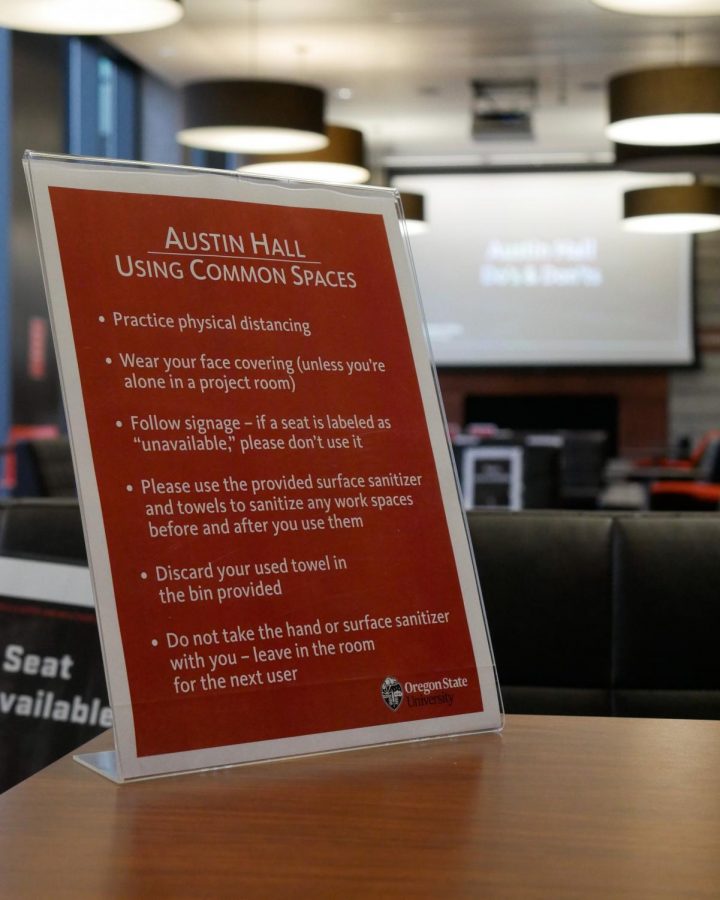Malick: More study spaces need to be available on weekends
November 23, 2020
Editor’s Note: This column does not represent the opinion of The Daily Barometer. This column reflects the personal opinions of the writer.
With COVID-19 restrictions still in full force, only about 10 of Oregon State University’s public study spaces are currently open. This may make it more difficult for some students to succeed academically. The majority of these spaces, however, are only open during the school week.
For many students, online classes have been a challenge. Between missing out on the traditional college experience and dealing with Zoom fatigue, it can be difficult to stay motivated. Many students may find it more difficult to focus as we move towards finals week and Winter term. This can be especially true for students who live in loud households, students who don’t have access to the internet at home or students who just want a change of scenery. They may struggle to find a readily-available study space.
On the Corvallis campus, the Valley Library study spaces were “not very busy” during midterms, said Steve Weber, coordinator of circulation services at the Valley Library. The library is currently open Monday through Friday, by reservation only. In fact, of the 10 indoor study spaces on campus, only Austin Hall’s computer labs are open on Saturdays and Sundays. There are several BeaverPrint locations open for use on the weekends.
There are also tents set up outside Valley Library, the Learning Innovation Center and in Peavy Plaza with access to WiFi, which are run on a first come, first serve basis. As the weather gets colder and the rainy season continues, however, these study spaces may become less usable.
In addition, five of the indoor study spaces on the Corvallis campus are reserved for College of Engineering, College of Forestry, and Honors College students. The College of Forestry computer labs are open to all OSU students, with the catch that College of Forestry students have priority.
Breanna Repp, an Honors College student, said that she has done most of her studying on campus this term.
Of her experience studying in the Honors College learning center the Students Learning UnderGround, she said, “I really enjoy studying in the SLUG because I feel a little bit more connected to people because there are others around and it is always a very calm and welcoming environment. They are also offering classrooms by reservation which is great when I want to do a zoom meeting I will need to speak in.”
She said she also feels very safe at the LInC, and that there are enough people to make her feel comfortable without being so many people that she’s concerned about social distancing.
The remaining four indoor study spaces on the Corvallis campus are the LInC, Austin Hall’s computer labs, the Memorial Union and the Valley Library. This begs the question: are there enough study spaces available to students on OSU’s Corvallis campus?
Weber said, “With limited resources to provide services to campus both in person and remote, we focused resources on providing a safer, moderated space.” The emphasis seems to be on quality and safety, as Weber went on to say, “With most classes being taught remotely, and OSU taking steps to reduce density on campus, we expected that our digital services would be very busy, and that the number of students using the library in person would change. Our digital services—like Ask a Librarian and course reserves—have been extremely busy.”
According to Weber, the last day to reserve a study space will be Nov. 25. “After the Thanksgiving break, we will have carryout service, printing and unreserved seating in Java II and outside tents.”
With plenty of reservations available and changes on the horizon, the question then becomes “how do I maximize my productivity with the time I have?”
Anika Lautenbach, coordinator of academic coaching & strategist programs at the Academic Success Center suggests several things for maximizing productivity.
“First, we recommend prepping for your study session. This includes creating a short, specific, and realistic to-do list. Starting a study session with one or two goals is a great way to frame the work you want to accomplish,” Lautenbach said.
Lautenbach also recommends prioritizing activities that can’t be done at home or in your dorm. Another key ingredient to maximizing your study time is using time management strategies, like the Pomodoro Technique. This gives you breaks to eat a snack, stretch or check your phone.
“Maybe you can focus for 15 minutes or 45 minutes—that’s great! The important thing is that you find something that works for you and that you build in breaks,” Lautenbach said.
“I used to love going to the Valley Library, but with the new restrictions I am not a fan of the locations within the library or the time limits,” Repp said. She also said two hours isn’t enough time for her, and that she often spent five hours at the SLUG lab.
“If they had longer reservation times I think I would definitely be working in there. I wish the reservations were longer, even just three hours.”











































































































